storytelling
for nonfiction writers
the power of stories
Or why after you read a business book, the stories stay with you longer than the concepts?
It’s because our brains are wired to pay attention to stories. Let me give you 5 quick science facts.
1
Stories create curiosity, which releases dopamine, a pleasurable hormone, in our brains.
2
Thanks to mirror neurons, stories cause our brains to fire up in the same patterns as the brain of whoever is telling the story. So there is a connection.
3
Stories engage our emotions, not just our reason.
4
Brain scans show that stories activate more areas of the brain than just factual information.
5
Interesting stories literally stop daydreams and command our attention.
In a world of Netflix, YouTube and a myriad of entertainers, you must learn how to tell engaging stories if you want to draw the attention of your audience.
So what is this course about?
This short course consists of 5 lessons:
1. Ideation
2. Characterization
3. Conflict & Structure
4. Dialogue
5. Types of Endings

The first lesson is IDEATION…
Diego is the author of two novels, 8 non-fiction books, and hundreds of articles and blogs as a science writer, a business writer, and a sales and marketing writer.
He is also a book coach helping business leaders and entrepreneurs write their first book fast so they can become thought leaders in their industries, gain authority and visibility and make more money.
